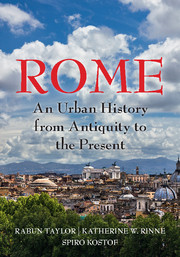Book contents
- Frontmatter
- Dedication
- Epigraph
- Contents
- List of Illustrations
- Acknowledgments
- Map
- INTRODUCTION
- 1 A BEND IN THE RIVER
- 2 A STORYBOOK BEGINNING
- 3 IDEOLOGICAL CROSSFIRE
- 4 BIG MEN ON THE CAMPUS
- 5 RES PUBLICA RESTITUTA
- 6 MEMORIALS IN MOTION: SPECTACLE IN THE CITY
- 7 THE CONCRETE STYLE
- 8 REMAKING ROME'S PUBLIC CORE: I
- 9 REMAKING ROME'S PUBLIC CORE: II
- 10 CRISIS AND CONTINUITY
- 11 RUS IN URBE: A GARDEN CITY
- 12 ADMINISTRATION, INFRASTRUCTURE, AND DISPOSAL OF THE DEAD
- 13 MAPPING, ZONING, AND SEQUESTRATION
- 14 TETRARCHIC AND CONSTANTINIAN ROME
- 15 TROPHIES AND TITULI: CHRISTIAN INFRASTRUCTURE BEFORE CONSTANTINE
- 16 WALLS MAKE CHRISTIANS: FROM FOURTH TO FIFTH CENTURY
- 17 A TALE OF TWO ROMES
- 18 THE ROME OF GOTHS AND BYZANTINES
- 19 CHRISTIAN FOUNDATIONS
- 20 FROM DOMUS LATERANI TO ROMANUM PALATIUM
- 21 THE LEONINE CITY: ST. PETER'S AND THE BORGO
- 22 VIA PAPALIS, THE CHRISTIAN DECUMANUS
- 23 THE URBAN THEATERS OF IMPERIUM AND SPQR
- 24 HOUSING DAILY LIFE
- 25 CHAOS IN THE FORTIFIED CITY
- 26 THE TIBER RIVER
- 27 HUMANIST ROME, ABSOLUTIST ROME (1420–1527)
- 28 PLANNING COUNTER REFORMATION ROME
- 29 PROCESSIONS AND POPULATIONS
- 30 MAGNIFICENT PALACES AND RHETORICAL CHURCHES
- 31 NEOCLASSICAL ROME
- 32 PICTURING ROME
- 33 REVOLUTION AND RISORGIMENTO
- 34 ITALIAN NATIONALISM AND ROMANITÀ
- 35 A CITY TURNED INSIDE OUT
- Glossary of Persons, Places, and Terms
- Works Cited
- Index
4 - BIG MEN ON THE CAMPUS
Published online by Cambridge University Press: 05 July 2016
- Frontmatter
- Dedication
- Epigraph
- Contents
- List of Illustrations
- Acknowledgments
- Map
- INTRODUCTION
- 1 A BEND IN THE RIVER
- 2 A STORYBOOK BEGINNING
- 3 IDEOLOGICAL CROSSFIRE
- 4 BIG MEN ON THE CAMPUS
- 5 RES PUBLICA RESTITUTA
- 6 MEMORIALS IN MOTION: SPECTACLE IN THE CITY
- 7 THE CONCRETE STYLE
- 8 REMAKING ROME'S PUBLIC CORE: I
- 9 REMAKING ROME'S PUBLIC CORE: II
- 10 CRISIS AND CONTINUITY
- 11 RUS IN URBE: A GARDEN CITY
- 12 ADMINISTRATION, INFRASTRUCTURE, AND DISPOSAL OF THE DEAD
- 13 MAPPING, ZONING, AND SEQUESTRATION
- 14 TETRARCHIC AND CONSTANTINIAN ROME
- 15 TROPHIES AND TITULI: CHRISTIAN INFRASTRUCTURE BEFORE CONSTANTINE
- 16 WALLS MAKE CHRISTIANS: FROM FOURTH TO FIFTH CENTURY
- 17 A TALE OF TWO ROMES
- 18 THE ROME OF GOTHS AND BYZANTINES
- 19 CHRISTIAN FOUNDATIONS
- 20 FROM DOMUS LATERANI TO ROMANUM PALATIUM
- 21 THE LEONINE CITY: ST. PETER'S AND THE BORGO
- 22 VIA PAPALIS, THE CHRISTIAN DECUMANUS
- 23 THE URBAN THEATERS OF IMPERIUM AND SPQR
- 24 HOUSING DAILY LIFE
- 25 CHAOS IN THE FORTIFIED CITY
- 26 THE TIBER RIVER
- 27 HUMANIST ROME, ABSOLUTIST ROME (1420–1527)
- 28 PLANNING COUNTER REFORMATION ROME
- 29 PROCESSIONS AND POPULATIONS
- 30 MAGNIFICENT PALACES AND RHETORICAL CHURCHES
- 31 NEOCLASSICAL ROME
- 32 PICTURING ROME
- 33 REVOLUTION AND RISORGIMENTO
- 34 ITALIAN NATIONALISM AND ROMANITÀ
- 35 A CITY TURNED INSIDE OUT
- Glossary of Persons, Places, and Terms
- Works Cited
- Index
Summary
IN JANUARY OF 52 B.C.E., A FANATICAL FOE OF THE ARISTOCRACY, PUBLIUS Clodius Pulcher, was murdered by a rival gang. The populist demagogue had recruited neighborhood and trade associations to pass his inflammatory legislation and enforce his violent tactics. His success relied not just on shrewd advocacy for the urban poor, but on an apparatus of neighborhood leaders whose patronage networks enabled mass mobilization of political gangs. Clodius’ final muster occurred at his funeral. His enraged followers cremated his body on a makeshift pyre at the Curia – the main one, on the Forum – which promptly went up in flames. The Comitium and its dependencies were also destroyed.
Apt symbol of the wreckage of the Roman state, the seat of government lay in ruins for four years. It fell to Julius Caesar to rebuild it during his dictatorship (48–44 B.C.E.). He did it on his own terms and at fabulous expense, seizing the opportunity to purchase private property just north of the Forum for a new rectangular civic temple enclosure, the Forum of Caesar. Land prices in this exclusive neighborhood, long an enclave of senatorial residences, were exorbitant. Out in the public area of the Comitium, the Rostra was detached from the Curia and placed roughly on the central axis of the short northwest end (Fig. 22). The Curia, now aligned with the old Forum's northeast side, anchored the south corner of the Forum of Caesar, the first of an eventual cluster of five “imperial fora” (Fig. 23). To look at, the new forum was not particularly original, being a hybrid of the temple cum portico already familiar on the Circus Flaminius and the colonnaded hillside temple precincts in famous sanctuaries around Latium. Even the notion of appending a curia to an enclosed portico had been anticipated in Pompey's alternate Senate chamber attached to his theater-portico complex. (Caesar's artful assassins would ensure that he himself fell in his fallen rival's curia, before a statue of Pompey.) The novelty resided in the forum's intended civic function – specifically, as a new kind of venue for law courts – and its profoundly dynastic cast. Pompey's patron goddess, Venus Victrix, had been something of an abstraction. Caesar's, Venus Genetrix, was by contrast known to everyone as the mother of the founder-hero Aeneas, whom the Julian clan claimed as a direct ancestor.
- Type
- Chapter
- Information
- RomeAn Urban History from Antiquity to the Present, pp. 32 - 42Publisher: Cambridge University PressPrint publication year: 2016



